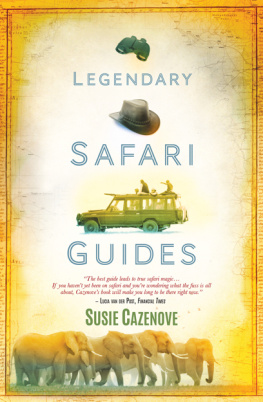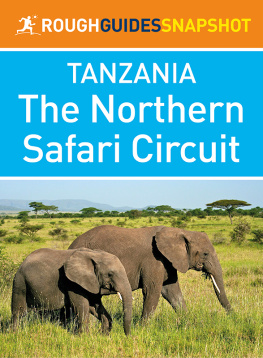
Susie Cazenove, 2014
All rights reserved. No part of this book may be reproduced or transmitted in any form or by any means, electronic or mechanical, including photocopying, recording or any information storage or retrieval system, without permission from the copyright holder.
ISBN: 978-1-920434-94-6
e-ISBN: 978-1-920434-95-3
Published on behalf of Susie Cazenove by
Bookstorm (Pty) Ltd
PO Box 4532
Northcliff 2115
Johannesburg
South Africa
www.bookstorm.co.za
Parts of this book were first published in Licensed to Guide , Jacana Media, Johannesburg 2005
Proofread by John Henderson
Photographs by Susie Cazenove except photo of Grant Cumings by Francois dElbee and photo of Howard Saunders by Stephanie Dloniak
Illustrations by Jessica Hoffman
Cover photo by Michael Lorentz, Passage To Africa
Cover design by publicide
Book design and typesetting by Ren de Wet
Ebook by Liquid Type Publishing Services

SUSIE CAZENOVE

To my husband Dick
and my children Heather, Jessica, Dominic
and Olivia
CONTENTS
PREFACE
When I left Cazenove and Loyd Safaris, a travel company that my business partner, Henrietta Loyd, and I had set up to specialise in providing African holidays, I realised there was one crucial ingredient in any trip I have ever sent anyone on the guide. It is the guide who makes both the safari and its African backdrop an unforgettable experience. This book is about those people.
I have travelled extensively throughout southern and eastern Africa during my career as a tour operator, and in this book I draw on my own deep passion for the continent and on my personal observations. There are many excellent professional guides with impeccable reputations. I have not had the opportunity to travel on safari with all of the guides I have met, but the criterion for the guides I have selected to profile here is that I have been on safari with all of them. I have enjoyed their humour and their stories, and this is the reason for writing this book: I would like to share some of their best experiences and stories with you, the guides own tales of adventure and hardship (and sometimes of love). This is a book about the lives theyve led; it tells of their concerns, hopes and plans for the future. They have helped me understand why they made the choices they did. Wherever possible, I have authenticated their family legends. I cannot tell their stories though without including some of my own too, because they are so closely linked to the guides I have travelled with.
The book also provides some background information about the places where the guides have worked or perhaps where their spiritual selves reside. For the reader who may never have experienced the terrain these people work in the intense heat, the luxuriance or sheer magnitude of the landscape a small description of each area is included.
My daughter, the artist Jessica Hoffman, has drawn magnificent charcoal portraits of the guides profiled, in each case capturing their personalities in her sketches.
So much has happened in the intervening years since my previous book about the guides that I decided to provide an update on the guides I wrote about and to include four more guides, one of whom is a Maasai woman. A few of them have now retired from guiding, but all are still deeply involved one way or another in the protection of wildlife and the continuation of tourism at its best in other words, exciting, inspiring and thought-provoking tourism.
In 2004, around the time I was doing most of the first interviews with the guides, we thought that poaching in Africa was under control. But, unfortunately, that is not the case. Increasing affluence in the Far East has given rise to the most gruesome and hideous trade in animal body parts. Thousands of elephants and rhinoceroses are being slaughtered in many horrific ways, not only with guns and machetes but also with poison, which has now become a favoured weapon. Poison laid on the ground kills any creature that eats it, and the animals die in agony, and its a trade not just in the animals that we are aware of as the usual victims. Clive Stockil, a Zimbabwean conservationist, told the audience at a lecture he gave at the Royal Geographical Society in London in 2013 about how an elephant had its carcass poisoned after the tusks had been removed so that hundreds of vultures could be killed for their beaks. What next?
Charitable foundations, such as Tusk, do an incredible job to raise awareness and to help with projects in the field. It is enormously expensive to create sound security systems to provide protection, but the battle goes on even though very few can afford the equipment.
Tourism is also helpful in mitigating the trade and the guides realise this evil can only end through public pressure. They do their very best to educate and create awareness not only in Africa but worldwide, wherever they are.

THE WORLD
OF SAFARI TRAVEL
Journeys through Africa with specialist guides can have a significant impact on those who make them. Life is never quite the same again you have joined an exclusive club whose members alone truly understand how intense and moving the African experience can be.
I t is surprising how many safari guides there are, given the range of attributes they must possess. The guide must have detailed knowledge of all the animals and birds, and their habitats. He must also be an excellent host, organiser and mechanic; he must be good with the gun, and an intelligent conversationalist, a paramedic and a mind reader. Above all, he must remain enthusiastic and alert all day long.
I say he because, in reality, most safari guides are men. There are some women who take to it, but, by and large, it is a male-dominated profession. Politically incorrect that may be, the fact is most people take comfort from the masculine strength of their guides. This is partly because the guides guests are completely dependent on him, and this is not always an easy situation for people who are normally used to being in control. Some people become terrified in the bush and find that not being in control is difficult to deal with. Someone may be used to managing people at work, for example, and giving the orders, but finds that he or she cannot be in control when walking in lion-infested terrain and has to acknowledge the guide as the superior.
Women often find the guides irresistible, which is not really surprising. When people are catapulted out of their familiar lives into an unexpectedly stimulating setting, where the earthy smells, endless vistas, glittering stars and, most of all, the underlying edge of fear create a frisson of excitement that many may not have felt for years, a strong, confident, attentive man with a sense of humour can be very appealing! This phenomenon is known as khaki fever, and the guide usually handles it with great discretion and tact.
When I became involved in the safari business and travelled more extensively, I soon began to realise the impact the safari guides had on visitors. Good guides make the experience exceptional, not just because they open your eyes to the wildlife around you, but because they have come to terms with their own strengths and weaknesses. A mediocre guide may not ruin the experience, because no one can take away the beauty of the surroundings and the excitement of seeing the animals close up in their own environment, but a good one raises the experience to another level.
Next page








